Central Texas is a paradise for birdwatchers, offering diverse habitats that attract various bird species. This guide will introduce you to some of the most common species of birds in Texas, how to identify them, and the best spots to find them.
Central Texas Birds: Top Spots and Species to Discover
Central Texas is a paradise for birdwatchers, offering diverse habitats that attract various bird species. Whether you’re a seasoned birder or a novice, the Texas Gulf Coast provides ample opportunities to observe these fascinating creatures. This guide will introduce you to some of the most common species of birds in Texas, how to identify them, and the best spots to find them.
Top Bird Species to Discover in Central Texas
Northern Cardinal
- Identification: The Northern Cardinal is easily recognizable by its bright red plumage in males and the more subdued brownish-red in females. Both males and females are beautiful birds with a distinctive crest on their heads and a black mask around their faces.
- Habitat: These birds are commonly found in woodlands, gardens, shrublands, and wetlands. They are frequent visitors to bird feeders.
- Where to Spot: Northern Cardinals are widespread throughout Central Texas and can often be seen in urban parks and backyards.
Great Blue Heron
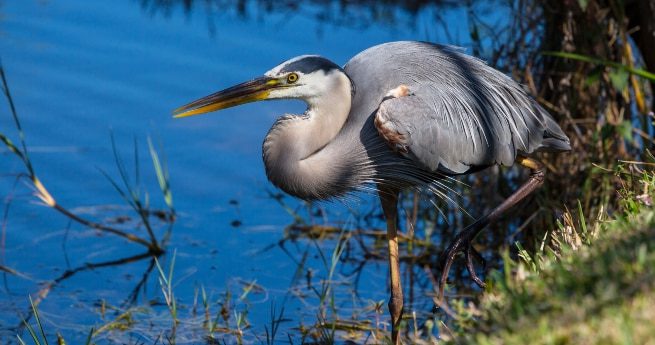
- Identification: The Great Blue Heron is a large wading bird with a long neck and legs. It has blue-gray feathers, a black plume on its head, and a sharp, yellow bill.
- Habitat: They inhabit wetlands, rivers, lakes, and coastal regions.
- Where to Spot: Look for Great Blue Herons along the shores of the Colorado River and other water bodies in Texas. You might see these birds while fishing in Matagorda, Texas.
Red-Tailed Hawk
- Identification: The Red-Tailed Hawk has a broad, rounded tail that is typically reddish-brown. They have a dark band of feathers across their bellies and a characteristic hoarse, screaming call.
- Habitat: Red-tailed hawks inhabit fields, deserts, and scrublands.
- Where to Spot: You can often see Red-Tailed Hawks soaring above open fields and roadsides.
White-Winged Dove
- Identification: White-Winged Doves are medium-sized with a distinctive white edge on their wings. They have a blue ring around their eyes and a long, slightly rounded tail.
- Habitat: These birds thrive in urban areas, agricultural fields, and scrub forests.
- Where to Spot: They are frequently seen in urban parks and residential areas.
Ruby-Throated Hummingbird
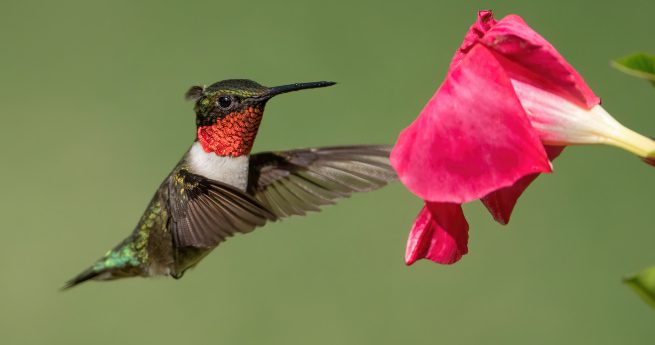
- Identification: This tiny bird is known for its iridescent green feathers and, in males, a bright ruby-red throat. They are incredibly agile fliers.
- Habitat: Ruby-throated hummingbirds are often found in gardens, woodlands, and meadows.
- Where to Spot: They are often seen near flowering plants and garden feeders.
Great Egret
- Identification: Great Egrets are large, white-wading birds with long necks and yellow beaks. They have long black legs and are often seen standing still as they hunt for fish.
- Habitat: They prefer freshwater and saltwater marshes, ponds, and shorelines. You might be able to see Great Egrets while fishing in Palacios.
- Where to Spot: Great Egrets can be spotted along the wetlands and marshes, particularly near Matagorda Bay.
Scissor-Tailed Flycatcher
- Identification: This bird is easily identifiable by its long, forked tail. It has pale gray upperparts, white underparts, and salmon-pink flanks.
- Habitat: This bird thrives in open fields, prairies, and savannas.
- Where to Spot: Scissor-tailed Flycatchers are often seen perched on wires and fence posts in open areas.
Carolina Chickadee
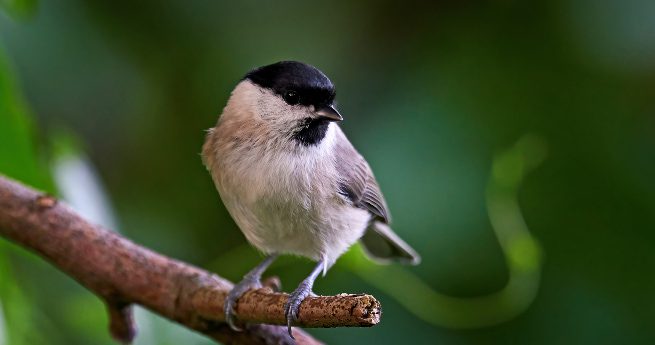
- Identification: Carolina Chickadees are small birds with a black cap and bib, white cheeks, and grayish wings and body. They are known for their distinctive "chick-a-dee-dee-dee" call.
- Habitat: These birds are commonly found in deciduous and mixed woodlands and suburban areas.
- Where to Spot: Carolina Chickadees can be found in forests, parks, and residential areas across Central Texas.
Painted Bunting
- Identification: The Painted Bunting is one of the most colorful songbirds in North America. Males have blue heads, green backs, and red underparts, while females and babies are greenish-yellow.
- Habitat: They prefer brushy areas, woodland edges, and riparian zones.
- Where to Spot: Painted Buntings are often seen in the dense underbrush, especially during the breeding season.
Black-Crested Titmouse
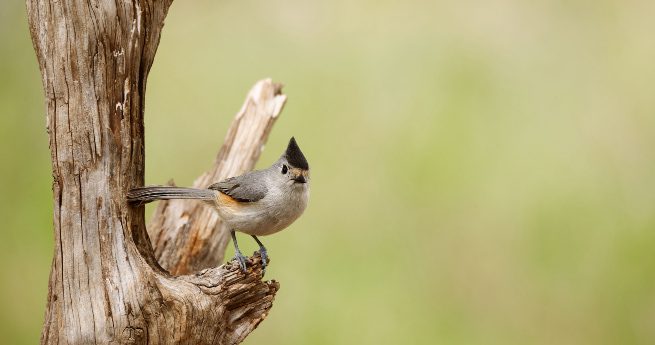
- Identification: The Black-Crested Titmouse has a gray body, black crest, and white face with a black patch above the bill. It is an active and curious bird.
- Habitat: Their preferred habitats are oak woodlands, mesquite brushlands, and urban parks.
- Where to Spot: Look for Black-crested Titmice in wooded areas and parks.
Golden-Cheeked Warbler
- Identification: This small songbird has bright yellow cheeks, a black throat, and white underparts with black streaks on the sides. It is an endangered species.
- Habitat: Golden-cheeked warblers are found in mature juniper-oak woodlands.
- Where to Spot: They are primarily seen in the Texas Hill Country, including Balcones Canyonlands National Wildlife Refuge.
House Finch
- Identification: The House Finch is a small bird with a conical beak and white wing bars on grayish-brown wings. Males have bright red plumage on their heads and chests, while females are brown and streaked.
- Habitat: They are commonly found in urban and suburban areas, as well as in rural farmlands.
- Where to Spot: House Finches are often seen at bird feeders and in gardens.
Blue Jay
- Identification: The Blue Jay is a striking bird with bright blue plumage, a white chest, and a black necklace. They have pointed wings and a loud, distinctive call.
- Habitat: These birds are found in forests, woodlands, and urban areas.
- Where to Spot: Blue Jays can mostly be seen in parks and wooded areas.
Black Vulture

- Identification: Black Vultures have black plumage, a bare black head, and white wingtips visible in flight. They have a shorter tail compared to the Turkey Vulture.
- Habitat: They are commonly found in open areas, fields, and near roadways.
- Where to Spot: Black Vultures are often seen soaring in groups or perched on trees and utility poles.
Mourning Dove
- Identification: Mourning Doves have a slender body and a long tail. They are light gray and brown with black spots on their wings.
- Habitat: These birds are found in open fields, woodlands, and urban areas.
- Where to Spot: Mourning Doves are common in backyards, parks, and open spaces.
Eastern Bluebird
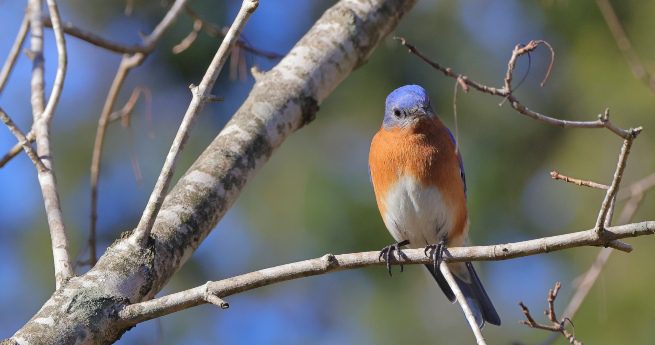
- Identification: The Eastern Bluebird has blue upperparts, a reddish-brown chest, and a white belly.
- Habitat: These common backyard birds prefer open fields with scattered trees and forest edges.
- Where to Spot: Eastern Bluebirds can be found in meadows, orchards, and along rural roads in Central Texas.
Turkey Vulture
- Identification: Turkey Vultures are a dark brown or black bird with a bare red head and a distinctive flight pattern with wings held in a V shape.
- Habitat: They are found in open and semi-open areas, including forests and deserts.
- Where to Spot: Turkey Vultures are commonly seen soaring in the skies, often near roadkill or other carrion.
Top Spots for Birdwatching in Central Texas
Matagorda Bay Nature Park
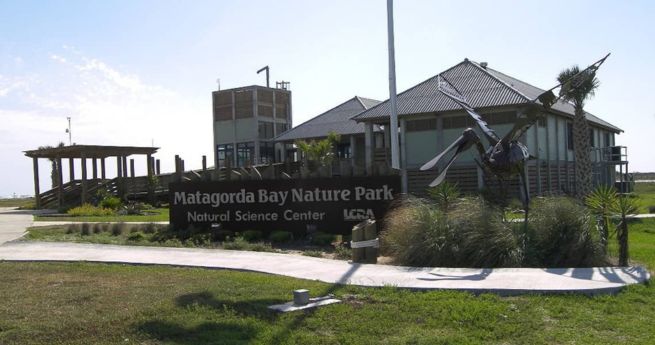
Matagorda Bay Nature Park is a prime location for birdwatching along the Texas Gulf Coast. The park's diverse habitats, including marshes, beaches, and woodlands, attract various birds in Central Texas. It's an ideal spot for observing wading birds, shorebirds, and songbirds.
Palacios and Bay City
The coastal areas around Palacios and Bay City, like the Tres Palacios Loop, offer excellent birdwatching opportunities. These regions are part of the Central Flyway, making them hotspots for migratory birds. Look for pelicans, herons, and egrets along the shores and wetlands.
Colorado River
The Colorado River provides a habitat for numerous bird species, especially waterfowl and waders. Paddling along the river can give you a unique vantage point for birdwatching.
Lake Texana State Park
Lake Texana State Park is another fantastic birdwatching destination. The park's lakes, forests, and grasslands support many birds. Watch for woodpeckers, warblers, and waterfowl during your visit.
Balcones Canyonlands National Wildlife Refuge
Balcones Canyonlands National Wildlife Refuge is crucial for the preservation of the endangered Golden-Cheeked Warbler. The varied terrain of canyons, woodlands, and savannas provides habitat for many other bird species as well.
Tips for Successful Birdwatching
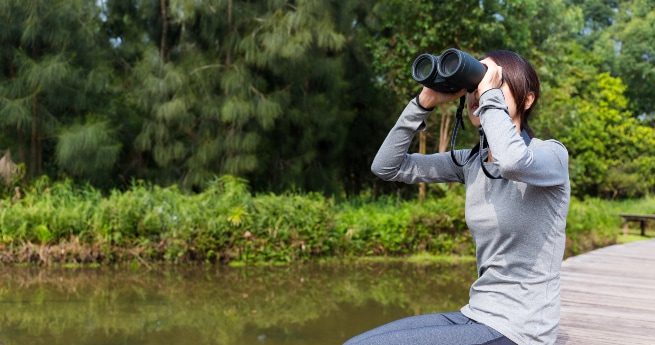
- Bring the Right Gear — A good pair of binoculars and a field guide to the birds of Texas are essential tools for birdwatching.
- Visit at the Right Time — Early morning and late afternoon are the best times for birdwatching when birds are most active.
- Be Quiet and Patient — Birds are easily startled, so move slowly and quietly. Patience is crucial in observing birds.
- Take Notes — Keep a journal of the birds you see, including details about their behavior and habitat. This can help you learn more about the species you encounter.
Become a Part of Our Birdwatching Paradise in Palacios
Would you like to have a place of your own to watch for birds in Central Texas?
Palacios is directly in the main bird migration path and holds the record for most species seen in a single weekend! Book a tour of our build-ready homesites at Beachside to see why we (and so many others!) love calling our coastal town of Palacios “home.”

